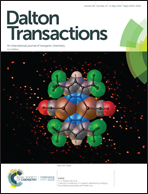Phosphonate-assisted tetranuclear lanthanide assemblies: observation of the toroidic ground state in the TbIII analogue†
Abstract
The reaction of LnCl3·6H2O with a multidentate flexible Schiff base ligand (LH4), H2O3PtBu and trifluoroacetic acid (tfaH) afforded a series of homometallic tetranuclear complexes, [Ln4(LH2)2(O3PtBu)2(μ2-η1η1tfa)2][2Cl] (Ln = DyIII (1), TbIII (2) and GdIII (3)). The tetranuclear lanthanide core contains two structurally different lanthanide centres, one being in a distorted trigonal dodecahedron geometry and the other in a distorted trigonal prism. Complexes 1–3 were investigated via direct and alternating current (DC and AC) magnetic susceptibility measurements. Only 1 revealed a weak single-molecule magnet (SMM) behaviour. Alternating current (ac) magnetic susceptibility measurements on 1 reveal a frequency-dependent out-of-phase signal. However, the absence of distinct maxima in the χ′′ peak (within the temperature/frequency range of our experiments) prevented deduction of the experimental energy barrier for magnetization reversal (Ueff) and the relaxation time. We have carried out extensive ab initio (CASSCF + RASSI-SO + SINGLE_ANISO + POLY_ANISO) calculations on complexes 1–2 to gain deeper insights into the nature of magnetic anisotropy. Our calculations yielded only one exchange coupling parameter between the two LnIII centres bridged by the ligand (neglecting the exchange between the LnIII centres that are not proximal wrt each other). All the extracted J values indicate a weakly antiferromagnetic coupling between the metal centres (J = −0.025 cm−1 for 1 and J = −0.015 cm−1 for 2). Calculated exchange coupled Ucal values of ∼5 and ∼1 cm−1 in 1 and 2 respectively nicely corroborated the experimental observations regarding weak and no SMM characteristics. Our calculations indicated the presence of a net single-molecule toroidal (SMT) behaviour in complex 2. On the other hand, fitting the magnetic data (susceptibility and magnetization) in the isotropic cluster 3 revealed weak AFM exchange couplings of J1 = 0.025 cm−1 and J2 = −0.020 cm−1 which are consistent with those for GdIII ions.

- This article is part of the themed collection: Inorganic chemistry of the p-block elements


 Please wait while we load your content...
Please wait while we load your content...